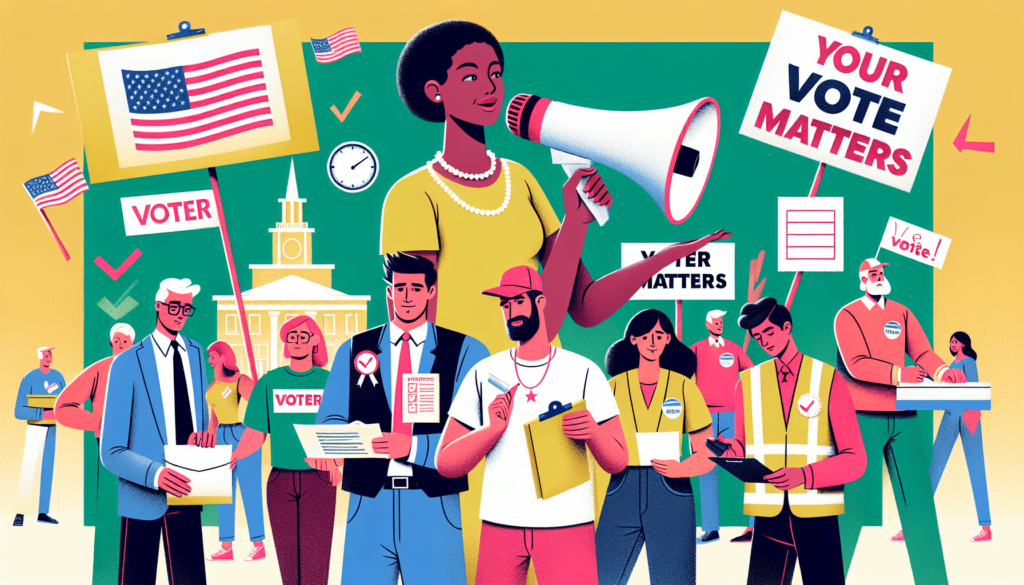In the world of politics, negative campaigning from opponents can be a frustrating and disheartening experience. It is no secret that mudslinging and personal attacks have become a common tactic used to discredit opponents and gain an advantage. However, instead of succumbing to the negativity, there are effective strategies you can employ to maintain your integrity and focus on the issues that matter. This article explores various approaches to handling negative campaigning, empowering you with the tools to stay positive and move forward amidst the chaos.
Prepare yourself mentally
Preparing yourself mentally is crucial when faced with negative campaigning from opponents. It can be emotionally taxing, but acknowledging and understanding your emotions is the first step. It’s normal to feel frustrated or angry, but don’t let those emotions consume you. Take deep breaths, focus on your goals, and remind yourself of the positive impact you want to make. By staying positive and keeping your eye on the bigger picture, you’ll be able to navigate through the challenges more effectively.
Acknowledge your emotions
When negative campaigning comes your way, it’s important to acknowledge the impact it has on your emotions. It’s completely natural to feel upset, frustrated, or even betrayed. Allow yourself to experience these emotions, but don’t let them dictate your actions or define your campaign. Acknowledging your emotions will help you address them and move forward with a clear mind.
Focus on your goals
In the face of negative tactics, it’s crucial to stay focused on your goals. Remind yourself why you decided to run for office in the first place. Visualize the positive change you want to bring to your community. By keeping your goals at the forefront of your mind, you can avoid getting caught up in the negativity and stay motivated to push forward.
Stay positive
Negativity can be contagious, but it’s important to rise above it. Instead of engaging in a war of words or stooping to your opponents’ level, focus on maintaining a positive campaign. Highlight the issues that matter to you, present your plans and solutions, and stay true to your principles. By showcasing your positivity and integrity, you’ll attract supporters who are looking for a candidate they can trust.
Seek support
Dealing with negative campaigning can sometimes feel isolating, but remember that you’re not alone. Seek support from friends, family, and fellow campaign members who can provide a listening ear and valuable advice. Lean on them when you need to vent or gain perspective. Additionally, consider reaching out to mentor figures or professionals who have gone through similar experiences. Their wisdom and guidance can be invaluable during challenging times.
Avoid engaging in negative tactics
When faced with negative tactics from your opponents, it’s important to rise above and avoid playing their game. By staying focused on the issues, maintaining your integrity, responding with facts, and avoiding personal attacks, you can keep your campaign elevated and focused on what truly matters.
Stay focused on the issues
One of the most effective ways to combat negative campaigning is to stay focused on the issues that matter to you and your constituents. Don’t get drawn into personal attacks or engage in mudslinging. Instead, consistently highlight your stance on key topics and emphasize the solutions you bring to the table. By keeping the conversation centered on the issues, you’ll appear more professional and trustworthy to voters.
Maintain your integrity
Maintaining your integrity is vital in the face of negative tactics. Refrain from spreading false information, engaging in deceptive practices, or resorting to personal attacks. Remember that your campaign is not just about winning, but about making a positive impact. By acting with integrity, you’ll demonstrate your commitment to serving the needs of your community and earn the respect and trust of voters.
Respond with facts
Facts are powerful tools when it comes to countering negative tactics. If false allegations or misinformation are spread about your campaign, don’t shy away from addressing them directly. Gather evidence that supports the truth and present it clearly to key stakeholders. By responding with facts, you’ll not only debunk false claims but also showcase your commitment to transparency and honesty.
Avoid personal attacks
Engaging in personal attacks not only damages your own campaign but also undermines the democratic process. Instead of stooping to your opponents’ level, rise above and consistently focus on the issues. Address policy differences respectfully and provide evidence to support your positions. By avoiding personal attacks, you’ll maintain the high ground and show voters that you prioritize respectful discourse and constructive solutions.
Develop a strong message
Building a strong and compelling message is essential to connecting with voters and standing out from your opponents. By defining your values and principles, highlighting your accomplishments, presenting clear plans and solutions, and differentiating yourself from your opponents, you’ll create a strong foundation for your campaign.
Define your values and principles
Defining your values and principles is the backbone of your campaign. Clearly articulate what you stand for and what you believe in. This will allow voters to understand your character and the guiding principles that shape your decision-making process. When your values and principles align with those of the community, it becomes easier for voters to trust and support you.
Highlight your accomplishments
Don’t be shy about showcasing your accomplishments. Highlight the positive impact you have made in your community, whether through leadership roles, volunteer work, or other achievements. Discuss how your actions have positively affected people’s lives and emphasize how you will continue to make a difference if elected. By highlighting your accomplishments, you’ll build credibility and show voters that you have a track record of getting things done.
Present clear plans and solutions
Voters want to know what you’ll do if elected. Present clear and specific plans and solutions for the challenges and issues facing your community. Outline your strategies, explain the steps you’ll take, and describe the expected outcomes. By demonstrating your thoughtfulness and preparedness, you’ll instill confidence in voters that you have the necessary skills to address their needs.
Differentiate yourself from opponents
In a crowded campaign field, it’s important to differentiate yourself from your opponents. Identify what sets you apart – be it your experience, expertise, or unique perspectives. Clearly communicate why voters should choose you over the other candidates. By highlighting your distinct qualities and explaining why they make you the best choice, you’ll stand out and attract more support.
Build a strong support base
A strong support base is vital for the success of your campaign. By connecting with your supporters, engaging with the community, utilizing social media, and hosting campaign events, you’ll expand your reach and inspire more people to get involved.
Connect with your supporters
Your supporters are your biggest advocates, so make a concerted effort to connect with them. Regularly communicate with them through newsletters, social media updates, or personal messages. Tapping into their insights and experiences can help you improve your campaign strategy and ensure that their voices are heard.
Engage with the community
Building a connection with the community is crucial for gaining trust and support. Attend local events, volunteer for community initiatives, and actively engage with residents. Actively listen to their concerns, showcase empathy, and demonstrate a genuine desire to make a positive difference. By engaging with the community, you’ll foster relationships, understand their needs, and gain valuable insights into the challenges they face.
Utilize social media
In the digital age, social media platforms are powerful tools for connecting with voters. Establish a strong online presence by regularly posting engaging content, sharing updates about your campaign, and responding to inquiries and comments. Leverage different social media platforms that are popular among your target audience and use them strategically to create a buzz around your campaign.
Host campaign events
Hosting campaign events provides a platform for you to share your message and connect with voters on a personal level. Organize rallies, town hall meetings, or meet-and-greets where you can engage in meaningful conversations, answer questions, and build relationships. These events create opportunities for voters to hear directly from you, and they foster a sense of community around your campaign.
Address false allegations
When false allegations are thrown your way, it’s important to address them decisively. By not ignoring false claims, gathering evidence to counter them, responding with clarity, and communicating the truth to key stakeholders, you can prevent misinformation from overshadowing your campaign.
Do not ignore false claims
Ignoring false claims can be detrimental to your campaign. Even if they seem minor or baseless, false allegations can quickly spread and damage your reputation. Address all false claims promptly and directly to ensure that your side of the story is heard. Ignoring them risks allowing your opponents to control the narrative and depict you in an unfavorable light.
Gather evidence to counter them
To effectively counter false allegations, gather evidence that disproves them. Collect documents, testimonials, or any other form of evidence that supports the truth. Present this evidence in a clear and concise manner to key stakeholders, such as voters, community leaders, and local media outlets. By providing solid evidence, you’ll discredit false claims and reinforce your credibility.
Respond with clarity
When addressing false allegations, respond with clarity and transparency. Clearly articulate the facts and explain why the allegations are false. Avoid getting defensive or confrontational. Instead, maintain a calm and composed demeanor as you present your case. By responding with clarity, you’ll reassure voters and stakeholders that you’re committed to honesty and transparency.
Communicate the truth to key stakeholders
It’s important to communicate the truth proactively and directly to key stakeholders. Reach out to local media outlets and request opportunities to share your side of the story. Organize press conferences or issue press releases that clearly outline the false allegations and present the truth. Additionally, engage with community leaders, attend public forums, and communicate with voters directly to address any concerns they may have. By communicating the truth, you’ll maintain trust and prevent false allegations from derailing your campaign.
Focus on your own campaign
While it’s important to analyze your opponents’ tactics, it’s equally essential to focus primarily on your own campaign. By staying organized and disciplined, consistently communicating your message, working hard to earn voters’ trust, and maintaining a strong presence in the community, you’ll be better positioned to generate support.
Stay organized and disciplined
Running a campaign is a complex endeavor, but staying organized and disciplined is key to success. Set clear goals, establish a schedule, and create a system to track your progress. Utilize tools and resources to streamline campaign tasks, such as volunteer management software or communication platforms. By staying organized and disciplined, you’ll be able to optimize your campaign operations and allocate your time and resources effectively.
Consistently communicate your message
Consistency is crucial when it comes to communicating your message. Craft a clear and compelling message that resonates with voters, and repeat it consistently throughout your campaign. Whether through speeches, campaign materials, or social media posts, keep your message at the forefront of all your communications. By consistently communicating your message, you’ll ensure that it permeates the minds of voters and creates a lasting impact.
Work hard to earn voters’ trust
Building trust is a cornerstone of any successful campaign. Be transparent, authentic, and accountable in all your interactions. Demonstrate that you are genuinely invested in the well-being of the community and that you have the competence and dedication to make a difference. By consistently working hard and following through on your commitments, you’ll earn the trust and respect of voters.
Maintain a strong presence in the community
To build a strong connection with voters, it’s important to maintain a visible and active presence in the community. Attend community events, volunteer for local causes, and build relationships with community leaders. Engaging directly with constituents allows you to understand their needs and concerns firsthand, and it shows them that you are invested in their well-being. By maintaining a strong presence in the community, you’ll forge stronger connections and inspire voter confidence.
Analyze your opponents’ tactics
Analyzing your opponents’ tactics can provide valuable insights into their strategies and help you refine your own campaign. Study their strategies, identify their weaknesses, learn from their successes, and adapt and improve your own campaign to maximize your chances of success.
Study their strategies
Examine your opponents’ strategies closely to understand their approach. Assess their messaging, tactics, and campaign infrastructure. Identify their key strengths and weaknesses. Analyzing their strategies will allow you to gain insights into what may be resonating with voters and what may not be as effective. This knowledge will help you refine your own campaign strategy and ensure that you remain competitive.
Identify their weaknesses
No campaign is perfect, including your opponents’. Take the time to identify their weaknesses. This may involve researching their past actions, scrutinizing their policy positions, or observing how they respond to adversity. Highlighting their weaknesses can help you differentiate yourself and attract voters who may share your concerns about the opposition. However, always focus on issues rather than engaging in personal attacks.
Learn from their successes
While it’s important to focus on your own campaign, you can still learn valuable lessons from your opponents’ successes. Identify the strategies and approaches that seem to resonate with voters. Analyze their messaging, campaign events, or community engagement efforts. Adapt these successful tactics to fit your own campaign style and objectives, and incorporate them into your strategy to strengthen your outreach.
Adapt and improve your own campaign
Even if you’re running a strong campaign, there’s always room for improvement. Use the insights gained from analyzing your opponents’ tactics to adapt and refine your own strategy. Modify your messaging, enhance your campaign events, or explore new avenues for community engagement. By continuously adapting and improving your campaign, you’ll remain dynamic and relevant throughout the election process.
Utilize endorsements
Endorsements from respected individuals and organizations can provide a significant boost to your campaign. Seek endorsements, highlight them in your campaign materials, leverage them to build credibility, and showcase broad community support for your candidacy.
Seek endorsements from respected individuals
Seek endorsements from individuals who are respected and admired in your community. These endorsements can come from community leaders, business owners, activists, or individuals with a track record of making a positive impact. Their support and endorsement can lend credibility to your campaign and convince undecided voters that you are the right choice.
Highlight endorsements in your campaign materials
Once you secure endorsements, highlight them prominently in your campaign materials. Feature them on your website, social media profiles, and campaign literature. This will allow voters to see that respected individuals or organizations believe in your candidacy. Social proof acts as a persuasive tool and can influence undecided voters to support your campaign.
Leverage endorsements to build credibility
Endorsements are valuable tools for building credibility. Utilize them to communicate your qualifications, values, and community standing. When you receive an endorsement, promote it actively through press releases and media outreach. Leverage your endorsers as campaign surrogates who can vouch for your character, expertise, and dedication. By leveraging endorsements, you’ll strategically reinforce your credibility and demonstrate that your campaign has broad support.
Showcase broad community support
Endorsements not only build credibility, but they also showcase broad community support for your campaign. Highlight the diversity and breadth of endorsements you receive, ensuring that they reflect the demographics and characteristics of your constituency. Demonstrating broad community support can inspire voters to believe that you have what it takes to effectively represent their interests.
Communicate with voters directly
Direct communication with voters is a powerful way to build rapport, address concerns, and showcase your commitment to being accessible and responsive. Attend public forums and debates, hold town hall meetings, knock on doors, and have meaningful conversations with constituents to understand their needs and provide solutions.
Attend public forums and debates
Public forums and debates provide platforms where voters can hear directly from the candidates. Attend these events and actively participate in the discussions. Engage in respectful and constructive debates, where you can present your ideas, challenge opposing viewpoints, and establish yourself as a knowledgeable and thoughtful candidate. Engaging with voters directly during these events will demonstrate your dedication to open dialogue and inclusive decision-making.
Hold town hall meetings
Town hall meetings are an excellent way to connect with voters on a more personal level. Organize these meetings where constituents can share their concerns, ask questions, and provide feedback. Listening attentively and responding thoughtfully will show voters that you value their opinions and are committed to representing their needs effectively.
Knock on doors and have conversations
Knocking on doors and having conversations with voters is a time-tested method of connecting on a more intimate level. Engage in conversations where you can listen to their concerns, explain your positions, and provide solutions to their problems. This direct outreach shows voters that you are willing to go the extra mile to understand their needs and address their interests.
Listen to concerns and provide solutions
During direct interactions with voters, actively listen to their concerns and provide thoughtful solutions. Understand the challenges they face and explain how your policies and plans can help overcome those challenges. Demonstrate empathy, show that you care about their well-being, and communicate your genuine commitment to making a positive difference. By actively listening and providing solutions, you’ll build trust, strengthen voter connections, and demonstrate your ability to be an effective representative.
Stay resilient and focused
Campaigning is a challenging process, and it’s crucial to stay resilient and focused amidst the ups and downs. Remain determined despite challenges, learn from setbacks and mistakes, keep your eye on the prize, and stay motivated until the end.
Remain determined despite challenges
Challenges and obstacles are bound to arise during any campaign. It’s essential to remain determined and focused on your goals, even in the face of setbacks. Learn from these challenges, adapt your strategy if necessary, and persevere through tough times. By maintaining your resolve, you’ll inspire your team and supporters to remain committed and optimistic.
Learn from setbacks and mistakes
Setbacks and mistakes are valuable learning opportunities. Analyze what went wrong, identify areas for improvement, and make the necessary adjustments. Seek feedback from supporters, volunteers, and campaign staff to gain different perspectives. By embracing setbacks as opportunities for growth, you’ll continuously improve your campaign strategy and enhance your chances of success.
Keep your eye on the prize
Running a campaign can be demanding, but it’s important to remain focused on the ultimate goal – winning the election and making a positive impact. Visualize yourself achieving your goals and remind yourself of the positive changes you’ll bring to the community. By keeping your eye on the prize, you’ll stay motivated and energized throughout the campaign process.
Stay motivated until the end
Maintaining motivation from the start of the campaign to the final day is essential. Celebrate small milestones and successes along the way to boost morale. Seek support from your team, friends, and family when you need a lift. Utilize self-care practices, such as exercise or meditation, to keep your energy levels high. By staying motivated until the end, you’ll continue to inspire those around you and maintain the drive needed for success.
In conclusion, handling negative campaigning from opponents requires mental preparedness, a focus on the issues, a strong message, a supportive base, addressing false allegations, and resilience. By taking a proactive approach, staying positive, and consistently communicating with voters, you’ll be well-equipped to navigate the challenges and run a successful campaign. Ultimately, remaining true to your values, principles, and the needs of your community will make a lasting impact and garner the trust of voters.

































